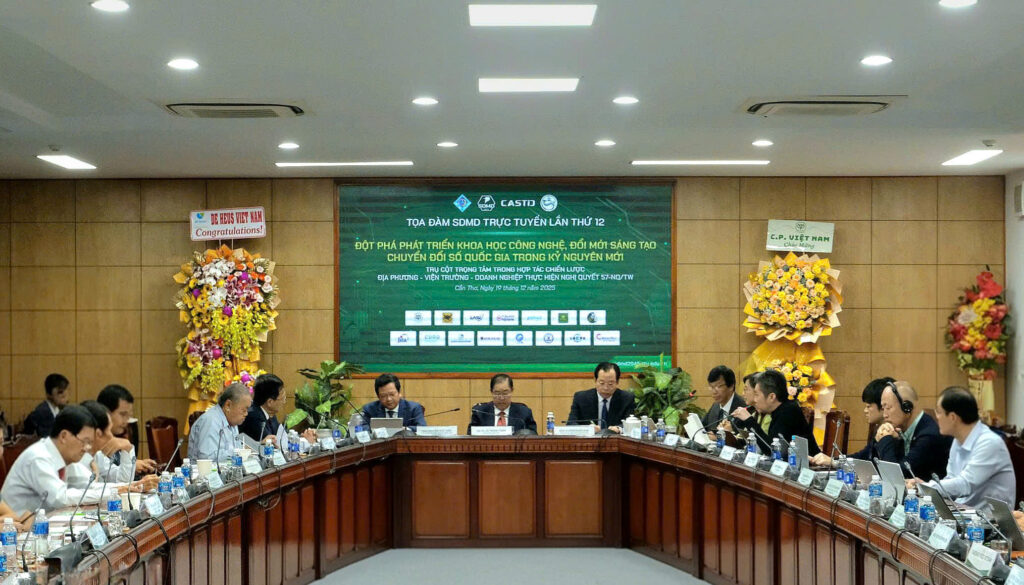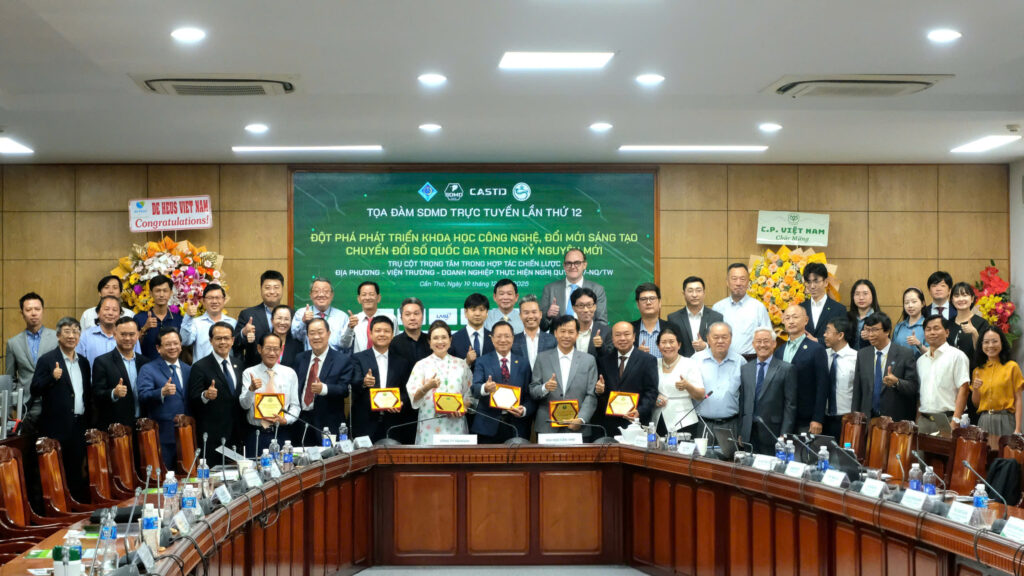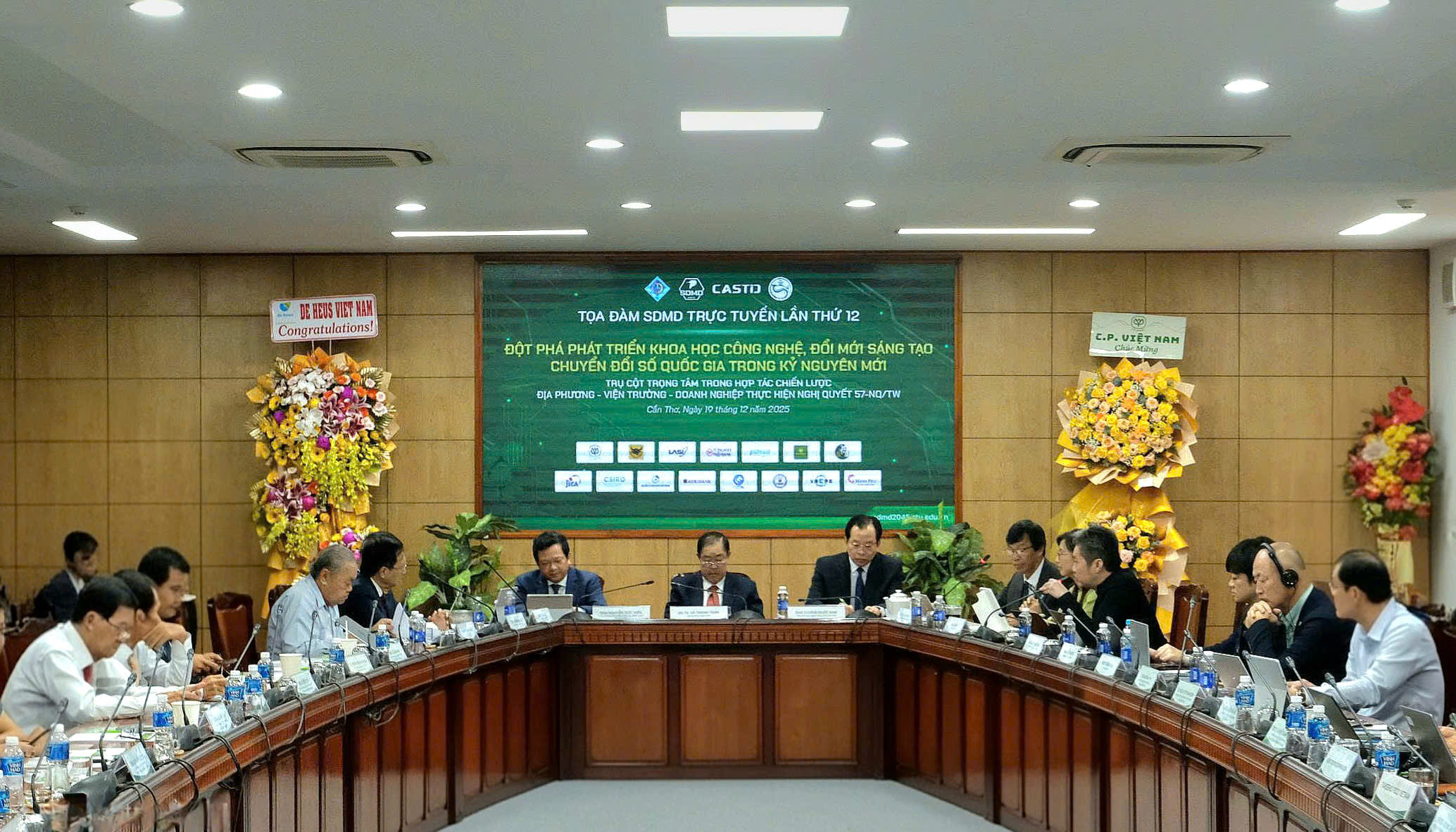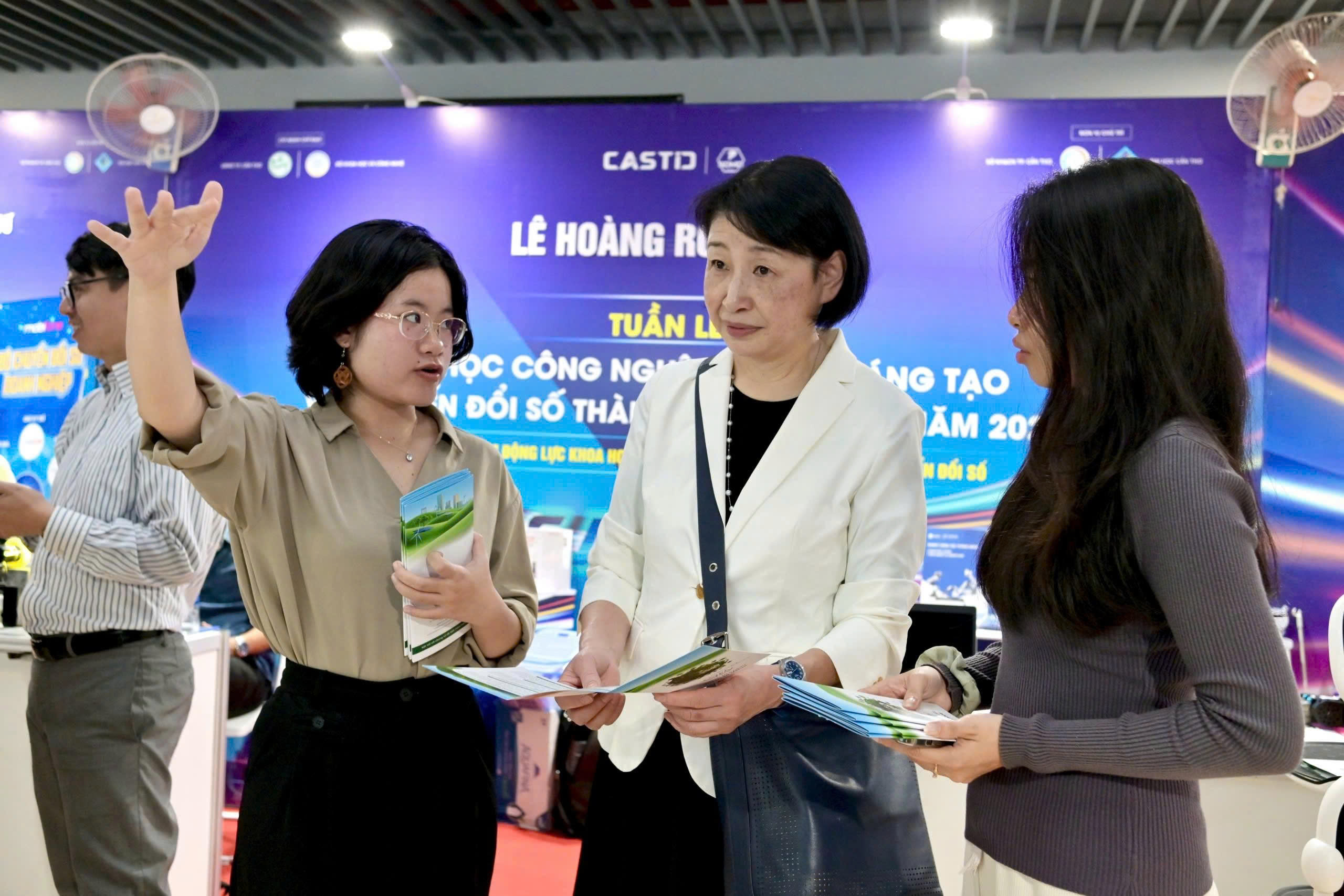On the morning of August 4, at the Government Headquarters, Prime Minister Pham Minh Chinh – Head of the National Steering Committee for the Development of the Semiconductor Industry – chaired the Committee’s second meeting.

Prime Minister Pham Minh Chinh chaired the second meeting of the National Steering Committee for the Development of the Semiconductor Industry
Also attending were Deputy Prime Minister Nguyen Chi Dung, the Standing Deputy Head of the Steering Committee. The meeting was livestreamed to several agencies, units, and universities in major cities nationwide.
In his opening remarks, Prime Minister Pham Minh Chinh emphasized that the Fourth Industrial Revolution is unfolding rapidly, particularly in areas such as semiconductors, artificial intelligence, cloud computing, and the Internet of Things, fields that are developing at great speed and contributing significantly to the overall growth of every nation, including Vietnam.
Globally, the semiconductor industry has a long history of development. It is a multi-sector industry with a rich and complex supply and production chain, expanding across multiple countries under the international division of labor. Every nation is striving for self-reliance, including autonomy in designing and manufacturing semiconductor chips, which play a crucial role and mission in the overall development of the world and of each individual country today. Every nation is pursuing research and production of semiconductor chips.
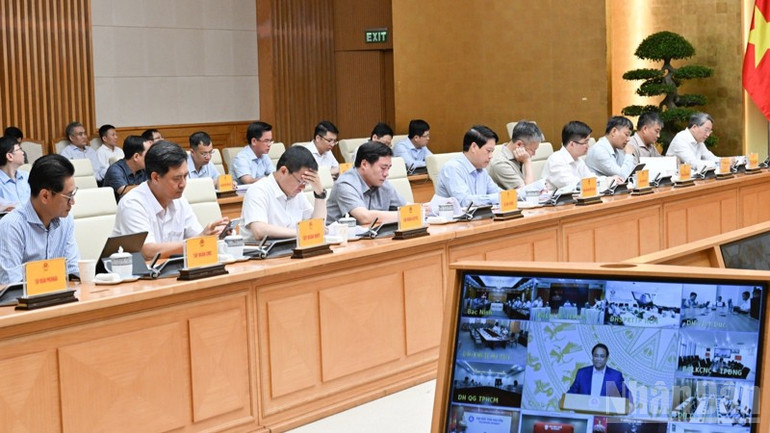
Delegates attending the meeting
Domestically, we are implementing various programs and plans, including Politburo Resolution No. 57-NQ/TW and resolutions of the National Assembly and the Government, to promote science and technology, innovation, and digital transformation. These efforts include advancing research, production, and manufacturing; training human resources; allocating resources; developing infrastructure; and establishing institutions to drive development.
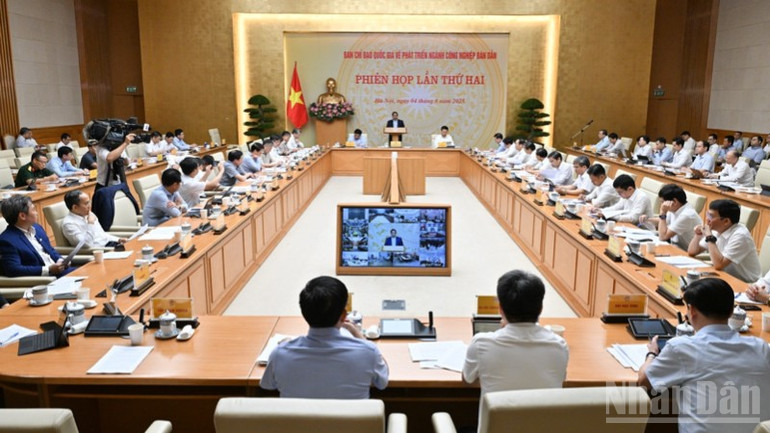
The scene of the meeting
The Prime Minister stated that, at the previous meeting, we agreed on several actions to implement tasks and solutions for the Semiconductor Industry Development Strategy through 2030, with a vision toward 2050, as well as the Human Resources Development Program for the semiconductor industry through 2030, with orientations toward 2050. In carrying out this strategy, Vietnam has achieved certain results. However, it must be frankly acknowledged that the country still faces many difficulties, obstacles, and challenges in developing this highly important semiconductor industry.
Vietnam is actively building an independent and self-reliant economy while proactively and substantively engaging in deep and effective international integration. If we aim to safeguard our independence, sovereignty, and territorial integrity, and to improve the material and spiritual well-being of our people, there is no other way but to increase labor productivity and make effective use of domestic resources, including human resources.
The development of AI and other activities largely depends on the semiconductor chip sector in order to move quickly, leapfrog, seize opportunities, develop efficiently, boost labor productivity, keep pace, advance alongside others, make breakthroughs, and rise above.
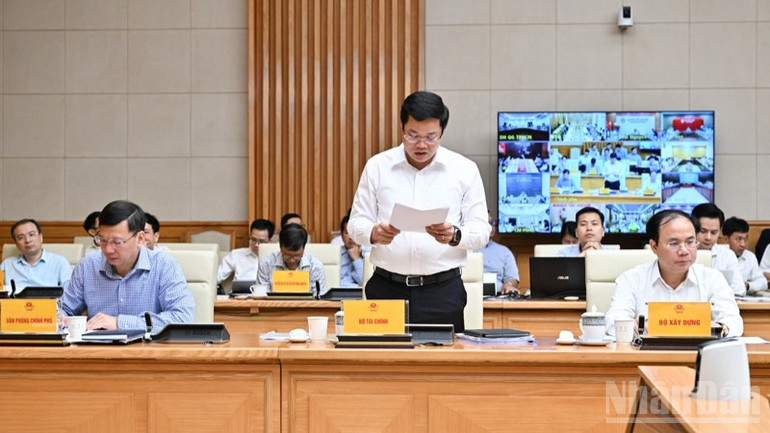
Leaders of the Ministry of Finance reported at the meeting
The Prime Minister requested that delegates clearly identify, after a period of implementation, what has been accomplished, what has not, the reasons why, and the lessons learned to promote the development of the semiconductor industry. Although Vietnam is a latecomer, can we move to the forefront, and how should we proceed? These are the issues that must be discussed, studied, and directed. Ultimately, it is essential to mobilize human resources, financial resources, and infrastructure-related resources to ensure that the semiconductor industry develops rapidly, in the right direction, and sustainably.
How should the model of collaboration among stakeholders, between the State, academia, and businesses, be structured? What must be done to leapfrog, seize opportunities, surpass others, and make breakthroughs? The Prime Minister expressed his hope that delegates would engage in in-depth discussions on this matter, reviewing what has been implemented and what has not, drawing lessons learned, and setting directions for the future. Given that resources and time are limited and experience is still modest, it is essential to determine the right approach and steps to leapfrog, seize opportunities, and move from a latecomer to a frontrunner.
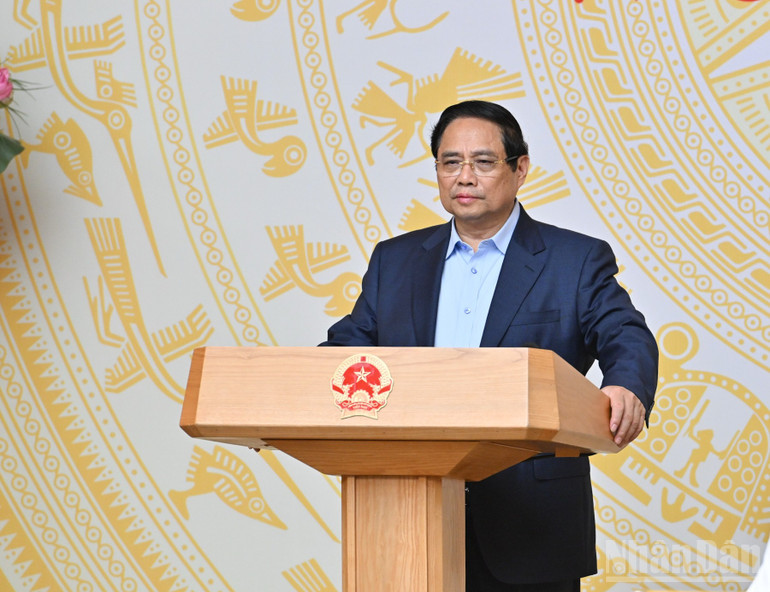
Prime Minister Pham Minh Chinh, Head of the Steering Committee, delivered remarks at the meeting
This is a long-term, highly technical process, and a single meeting cannot resolve all the issues at hand. However, it is necessary to define each task step by step, thereby enabling leadership, guidance, and calls for relevant stakeholders to harness Vietnamese intellectual capacity to design, produce, and participate in global supply and production chains. On that basis, we can draw lessons, identify bottlenecks that need to be removed, and determine which drivers should be added to promote progress.
How should organization, leadership, and direction be carried out to ensure close and effective coordination, creating a unified national strength rather than acting in isolation? How can we align all state institutions, universities, academies, and manufacturing enterprises to work together cohesively, avoiding fragmentation and small-scale efforts, following the principle that ‘if you want to go far, go together’? It is also necessary to identify key tasks to be completed from now until the end of the year, as well as in the years ahead.
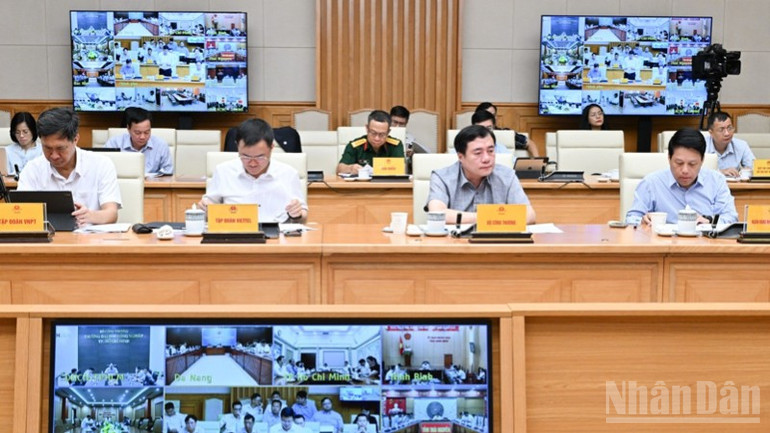
Delegates attending the meeting
The Prime Minister raised the question of whether this field should be incorporated into the education and training sector, with training starting directly from schools. He called on the delegates to draw from practical experience, leverage collective intelligence, and contribute ideas to reach consensus on key tasks in that spirit, with high determination, great effort, decisive actions, clear priorities, and a focus on completing each task thoroughly. Responsibilities must be assigned with ‘clear people, clear tasks, clear accountability, clear timelines, clear results, and clear authority.’ This is an issue that is both strategic and immediate, requiring us to ‘think far, see wide, think deeply, and act boldly.
The Prime Minister called for breakthroughs in the semiconductor industry, raising questions such as: What must our people do? What should the infrastructure look like? Where is the market? What roles should research institutions play? With this year’s growth target of 8.3–8.5%, Vietnam’s semiconductor industry must grow, take on a leading role, and create an ecosystem for the sector.
According to the Ministry of Finance, Vietnam’s semiconductor industry has made remarkable progress, demonstrating its potential and strong determination to rise in the development of strategic technologies. Vietnam is gradually moving deeper into established semiconductor processes, particularly in design, testing, and chip packaging. Specifically, the country now has over 50 chip design enterprises employing an estimated 7,000 engineers; approximately 15 enterprises are engaged in chip packaging, testing, and the production of semiconductor devices and materials, with around 6,000 engineers, not including over 10,000 technicians.
In addition, Vietnam has begun participating in higher value-added stages such as the production of semiconductor equipment, materials, and components. For the first time, semiconductor wafers have been produced in Vietnam by Coherent Group. Domestic semiconductor enterprises have also made notable advances: FPT has launched medical-sector chip products, Viettel has designed chips for 5G devices, and CT Group has commenced construction of a semiconductor chip packaging and testing plant. Notably, Vietnam is targeting several major milestones, including the establishment of its first chip manufacturing plant led by Viettel and the attraction of advanced packaging projects from leading companies such as Samsung.
Achieving these accomplishments in such a short period of time is not only the result of Vietnam’s own efforts and proactiveness, but also thanks to impressive strides in cooperation with major countries and economies in the semiconductor field, such as the United States, South Korea, Japan, Taiwan (China), France, the Netherlands, the United Kingdom, Italy, and Austria, as well as with leading technology corporations and organizations including Samsung, Apple, Google, Meta, Coherent, Foxconn, Microsoft, Marvell, Qorvo, SEMI, the U.S. Semiconductor Industry Association (SIA), and Taiwan’s Sustainable Economic Development Association, among others, to advance the semiconductor industry.
Accordingly, Vietnam is increasingly recognized globally as a promising destination for the semiconductor industry. A clear example of this is its selection as one of around 10 countries and economies worldwide to host an exhibition in the series of the world’s largest semiconductor exhibitions (SemiExpo), in collaboration with the global Semiconductor Equipment and Materials International (SEMI) and the National Innovation Center under the Ministry of Finance. SemiExpo 2025 will take place this November and has already confirmed the attendance of many top semiconductor business leaders, including, notably, senior executives from ASML of the Netherlands.
At the same time, Vietnam has also been selected by GITEX, the largest event organizer in the United Arab Emirates (UAE), to host an international innovation exhibition in 2026. Vietnam’s presence is becoming increasingly prominent at SEMI’s Semicon exhibition series in South Korea, Singapore, Taiwan (China), and Malaysia, with Vietnamese delegations comprising a diverse mix of government representatives, enterprises, research institutes, and universities. These delegations feature dedicated exhibition spaces showcasing the country’s semiconductor ecosystem along with ‘Make-in-Vietnam’ products. This represents a strong step toward integrating into the global supply chain, promoting high-quality human resources, and attracting investment in the semiconductor sector.
Even more notably, a symbolic milestone in Vietnam’s deep integration into the global semiconductor value chain is the decision by two of the world’s leading technology corporations, NVIDIA and Qualcomm, to select Vietnam as a strategic hub for AI and chip production, research, and development. The trust and investment of these two ‘tech giants,’ which are shaping global technology trends, have generated a powerful ripple effect, drawing in supply chains with substantial investment value into Vietnam, while also marking a significant leap in Vietnam’s position on the global semiconductor and technology map.
Vietnam is working with the United States to resume the operations of the ITSI Fund, aimed at enhancing Vietnam’s capabilities across all stages of the semiconductor supply chain, particularly in manufacturing and design, as well as implementing other cooperative projects under the Vietnam–U.S. Semiconductor Memorandum of Cooperation (MoC). Japan is supporting the training of semiconductor human resources through joint research projects and a program to train 250 PhD-level semiconductor experts by 2030 under the Japan–ASEAN Science, Technology, and Innovation Cooperation Project. South Korea is supporting a project to establish a Semiconductor Research Fund, with the Korea Institute of Science and Technology (KIST) collaborating with the Vietnam–Korea Institute of Science and Technology (VKIST). Taiwan (China) is providing full scholarships in semiconductors through cooperation between the Intense Scholarship Program and the National Innovation Center. European countries, including the Netherlands, France, Italy, the UK, and Austria, have collaborated with the National Innovation Center to organize bilateral semiconductor business forums and bring delegations of semiconductor enterprises to Vietnam for business matchmaking and collaboration.


